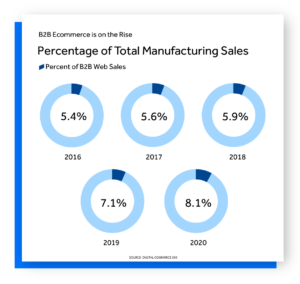

Manufacturers in particular have seen tremendous growth. In 2020, B2B ecommerce sales for grew year over year by 6.7% to about $458.7 billion from $430.0 billion in 2019.
According to research by Digital Commerce 360, B2B ecommerce now accounts for 8.1% of total manufacturing sales, increasing individual market share by 50% since 2016.
Manufacturers’ total digital sales through all channels—including ecommerce sites, online marketplaces, procurement and EDI—inched up by 2.4% year over year in 2020 to $3.63 trillion. –Digital Commerce 360
With all of this ecommerce growth, B2B companies now need to shift their attention to how to keep it going and continue to exceed customer expectations.
B2B firms investing in digital transformation are winning
75% of B2B companies expect 40% of revenue online by 2025. To reach a greater network of potential customers, B2B will need to enhance digital channels to provide an a more robust customer experience.
For example, Watsco, a leading B2B distributor of HVAC supplies, reported in its first quarter 2020 earnings that sales had grown by more than 8% during the pandemic, and this was largely attributed to an almost 100% increase in its customers’ use of its mobile app capabilities, including its order-online and pick-up-at-the-branch functionality.
Some of the largest and most successful B2B distributors, such as Grainger, HD Supply, and MSC have invested in and seen the benefits of using drop shipping along with fulfillment technologies to strategically broaden product assortment and drive sales. In fact, they relied on it more than ever as demand shifted to digital channels during the COVID-19 pandemic. Drop shipping is a viable and powerful model used by the world’s leading B2C retailers and works exceptionally well for B2B, particularly for distributors.
To take advantage of the B2B online growth opportunity, capitalize on the power of drop ship to:
Strategically expand assortment. Drop shipping allows B2B firms to offer broader inventory and selection, eliminating customers’ need to look elsewhere as new supply requirements emerge. Expanding product assortment through drop shipping enhances loyalty and drives incremental revenues.
Save millions in capital costs. With drop shipping, B2B sellers can create an extended network of suppliers, which enables them to quickly adjust as market conditions and demands change. This reduces both the risks that come with the inability to physically stock adequate inventory to meet customer needs or being caught with overstocks when demand drops.
Manage inventory risk. Working with more suppliers offers the potential of broadly distributed inventory, placing products closer to the delivery destination. With multiple suppliers on tap via the drop-ship model, distributors are ready for spikes in volume, while keeping the customer experience intact. This is all done without the risk of inventory ownership and the associated capital outlays and operating expenses.
For more about how drop shipping can drive B2B ecommerce success, download The Hidden Growth Lever: B2B Ecommerce and Drop Shipping white paper here. Or contact us.